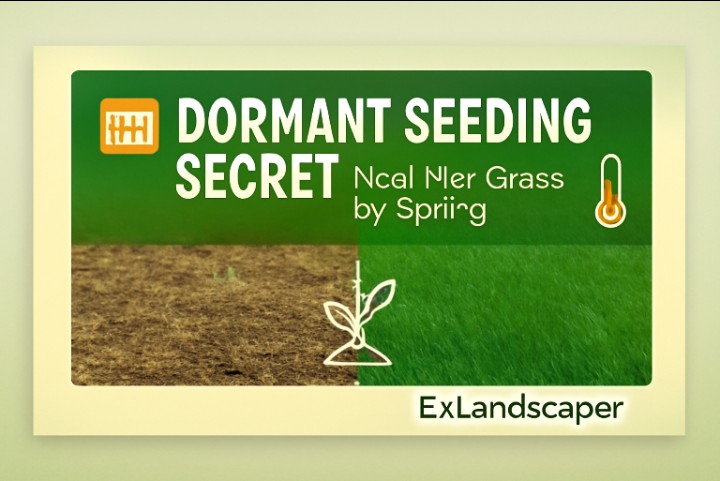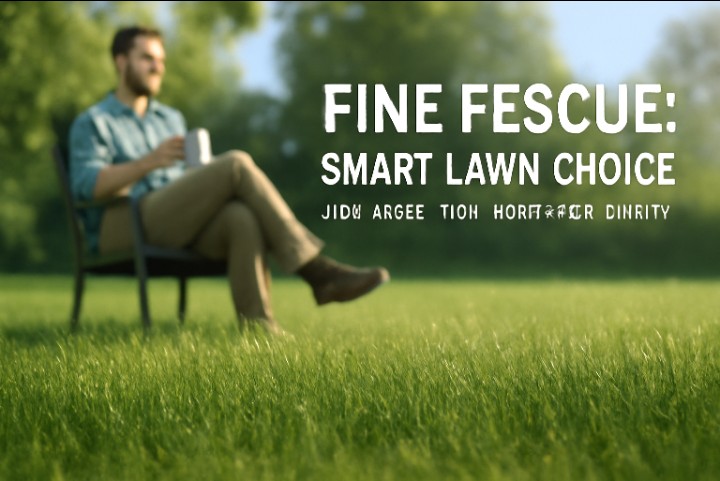The Secret Western City Homeowners Don’t Know About
Think November means your lawn dreams are over? Think again. Even as autumn winds blow through Western City and most of us pack away the garden tools, there is still one powerful move available. It’s called dormant seeding, and it could transform your yard for spring.
I know what you are thinking. Winter’s coming, why bother? Here is the thing: by late October through mid-November, your soil temperature has dropped just enough to prevent germination. Yet the ground remains workable and unfrozen. This narrow window lets you plant grass seeds that’ll sleep through winter and explode with growth come April and May.
You might assume November is too late for lawn work. But dormant seeding lets you repair or thicken the lawn when other options have disappeared. It’s your chance to address those problem spots nobody wants to see all year long.
Why Your Neighbors Won’t Have Better Lawns Next Spring
Suppose, it’s late May in Western City. Your dormant seeded patches are thriving while your neighbor’s bare spots are still struggling. Why? Because your grass got a head start. Your seeds germinated in early spring, right when soil temps hit 50 to 60 degrees. Established grass outpaces crabgrass and other weeds that want to claim those same spots.
The timing advantage is genuinely real. Grass seeds you plant now stay snug in the soil through winter. Come spring, they are already positioned to grow fast. Meanwhile, spring seeding often arrives too late. By then the soil is drying out and fewer conditions support healthy growth.
I have talked to Western City homeowners who tried this. Most noticed their dormant seeded areas looked thicker by June compared to areas that weren’t treated. That’s not coincidence. That’s biology working in your favor.
When to Actually Do This (Location Matters)
Here’s where Western City’s climate plays a role. Your seeding window typically runs from late October through mid-November. But weather matters more than the calendar.
Dormant seeding works best when soil is too cold to support grass seed germination below 50 degrees Fahrenheit but not yet frozen solid.
The ground temperature is the real signal. Once soil drops below 40 degrees consistently, you are in the sweet spot. You want cold enough to stop germination, yet the ground must stay unfrozen so seeds can nestle in. If you seed too early and a warm November spell arrives, seeds might germinate prematurely. Then a hard freeze kills the tender seedlings. That’s a wasted effort nobody wants.
If you are late and December arrives, don’t panic. Research at Kansas State tested dormant seeding at different times and found early February was best in their studies. Some folks in Western City actually wait until late winter when February or March arrive. That’s when freeze-thaw cycles really kick in and help work seeds into soil naturally.
Who Actually Benefits From This Method
Dormant seeding is not for every lawn situation. Be honest about yours first.
This works great if you have got thin lawns needing thickening throughout. Bare patches and dead spots are perfect candidates. Eroded or compacted soil areas respond well too. Lawns damaged by summer drought or disease can come back stronger.
This won’t help if your whole lawn is already lush and green. Thick, healthy lawns with dense coverage don’t need dormant seeding. Areas where soil contact is nearly impossible won’t work either. Established turf that already looks solid should be left alone.
If your lawn falls into the second category, dormant seeding wastes money and effort. Save your investment for the thin spots and problem areas instead.
Picking Seeds That Actually Grow in Western City
Not all grass performs equally in your area. Western City’s climate demands cool-season varieties that thrive in temperature swings and variable moisture.
Kentucky Bluegrass adapts well to our conditions. It’s tough, recovers from damage, and fills in gaps naturally. Many Western City homeowners swear by it for a reason. Fine Fescue handles shade better than most. If you have got trees around your property, this seed shines underneath them. Perennial Ryegrass germinates quickly and establishes fast. It’s reliable during our unpredictable springs.
For average Western City lawns, apply 3 to 4 pounds per 1,000 square feet. Always read labels carefully. Check germination rates and aim high. Avoid bargain seed blends where you can’t identify ingredients. Cheap seed often means cheap results and frustrated homeowners.
The Prep Work (This Determines Everything)
The truth is: preparation separates success from failure. Nobody who rushes prep work gets happy results.
Your first move is to mow lower. Cut your grass to about 2 inches, shorter than summer mowing. This opens the door so seeds reach soil instead of getting stuck in thatch. Rake everything up. Don’t leave clippings behind. I mean everything.
Next, loosen that soil. This is the critical move nobody should skip. Seeds need actual contact with soil particles, not just sitting on top of dead grass. For small Western City yards, a hand rake works fine. But honestly, if you are tackling anything larger than 500 square feet, a power rake saves your back and gets better results. Rent one from a local equipment place. Set it shallow, just a quarter inch into soil. You’re not trying to rip apart the lawn. You are opening the surface.
All that dead grass and debris the power rake pulled up? It’s got to go. Rake it away completely. Seriously, every bit. This stuff blocks seeds from touching soil directly. A clean surface is non-negotiable.
Walk your seeded area later. If you can see your footprints darkening the soil, you’ve got good seed contact. That’s the actual goal you are aiming for. That’s how you know the prep worked.
How to Actually Spread the Seed
Once prep is done, spreading is straightforward. Use whatever spreader you already own, broadcast or drop spreader, both work fine.
Spread seeds a bit heavier than the label recommends. I’d suggest 30 to 50 percent more seeds than the recommended rate because dormant seedings have greater risks from seedling mortality and washouts. The extra seeds give you insurance against winter losses. It’s a small price for better odds.
Walking on seeded areas after you are done is not necessarily bad. You will actually see where seeds made good contact with soil. Those spots grow in greener by spring. Footprints show you where the soil was properly prepared and where it might need more work.
Real Advantages That Actually Matter
When your dormant seeded grass germinates in spring, it gets there first. Early germination means established roots and shoots that crowd out crabgrass and other weeds competing for the same space. Your new grass wins territory before the troublemakers arrive. That’s not theory. That’s how plants actually compete.
Western City yards with mature oak and maple trees benefit significantly. Deciduous trees lose leaves slowly in spring. By the time they fully leaf out and block sunlight, your dormant seeded grass is already established. You capture growing season before shade arrives. It’s timing working in your favor.
Maybe you missed September’s prime seeding window. Life happens. Dormant seeding is your second chance. Instead of waiting a whole year, you can improve your lawn this fall. That’s worth considering.
Newly germinated grass from dormant seed gets several extra weeks of cool spring weather to build deep roots. When summer heat arrives, these roots help grass survive better. Stronger root systems mean tougher, healthier lawns. Simple physics and biology combined.
The Real Challenges You Need to Know
November and December temperatures fluctuate more than people expect. A warm 60 degree day can trigger germination. Then a hard freeze arrives. Those tender seedlings die. This is real risk in Western City’s unpredictable late fall. It happens to experienced homeowners too.
Let’s be clear about this: dormant seeding works, but spring seeding performed in September delivers better results overall. Late summer and early fall establishment is best. Dormant seeding can increase chances of new turf surviving through summer compared to typical spring seeding though. Plan accordingly.
Here is the annoying reality: both your dormant grass seeds and crabgrass seeds wake up around the same soil temperature, 50 to 60 degrees. They are competing for the same resources at the same time. Your new grass should win eventually, but it’s a tougher battle than you’d like.
Without snow insulation, wind can scatter seeds. Birds might snack on them. Exposed seeds also dry out faster. Western City winters with low snowfall create bigger risks. The inches of snow that fall help press seeds deeper into soil through freeze-thaw cycles.
During winter, avoid walking repeatedly on areas you have seeded. Frozen soil compacts easily under repeated foot traffic. Come spring, those compacted spots won’t grow well. Vary your paths. Give the seeded areas rest.
What to Do Through Winter (Not Much)
Here’s the beauty: dormant seeds need almost zero maintenance once applied. Don’t water. Don’t fertilize. Don’t do anything. Seeds are dormant and inactive. They’re not growing, so they don’t need food or hydration. Leave them alone completely.
Just protect them. Don’t let people or pets constantly walk the same path across seeded areas. If you use ice melt or salt products on nearby driveways, keep them away from the grass. Salt damages soil and new seedlings when spring arrives. That’s one mistake that lingers.
Another Option: Frost Seeding (Easier, Less Effective)
Frost seeding arrives later, typically February through March during freeze-thaw cycles. You spread seed on frozen ground with no soil prep. Winter’s natural cycles work the seed into soil.
The downside? Frost seeding works less reliably. You are banking on nature doing prep work. That’s inconsistent. Results vary wildly depending on winter conditions and how much freeze-thaw activity actually occurs.
Dormant seeding requires more upfront effort but delivers more predictable outcomes. Most Western City homeowners who try both prefer dormant seeding’s reliability.
Expert Tips for Getting This Right
Quality seed beats everything else. Don’t cheap out here. Your entire effort rests on seed quality. If the seed is mediocre, outcomes disappoint.
Seed-to-soil contact is the single biggest success factor. Invest time in prep work. Loose, clean soil is non-negotiable for good results.
Pick grass varieties suited to Western City specifically. Ask your local nursery which types thrive locally. Don’t guess based on what worked elsewhere.
Avoid dense, healthy lawns. Dormant seeding won’t improve them. Save your effort for problem areas that actually need help.
Understand your local climate. Seeding dates shift based on temperature patterns. Western City’s first consistently cold days arrive earlier than surrounding areas. Watch your local weather patterns and adjust accordingly.
Plan ahead for next year. Dormant seeding is your fallback, not your primary strategy. Prepare for September seeding next year to guarantee better results going forward.
Protect that investment. One winter of heavy foot traffic ruins months of preparation. Be intentional about where people walk.
What You will Actually See Next Spring
Your seeds sleep under cold soil through winter. March and April arrive and soil temps climb above 50 degrees. Seeds wake up and germinate.
Late April through May brings new grass shoots that emerge and spread rapidly. By early summer, your dormant seeded areas have integrated with existing turf, looking thicker and healthier than bare patches would. By June onward, the transformation becomes obvious.
The results don’t show immediately like spring seeding sometimes does. But the grass that does come in is stronger, deeper rooted, and more likely to survive summer stress. That’s worth the wait.
Making Your November Decision
Here in Western City, dormant seeding bridges the gap between missed fall opportunities and spring’s uncertain outcomes. It’s not perfect. But for thin lawns, bare patches, and damaged areas, it’s absolutely worth the effort.
Many Western City homeowners find that getting the prep work right makes all the difference. That’s where expertise matters. Companies like ExLandscaper understand local soil conditions and timing specifics that make dormant seeding succeed or fail in our area.
Check your soil temperature first. Is it consistently below 40 degrees? Are ground conditions workable? Will weather cooperate? If answers look positive, move forward.
Invest in quality seed. Do the prep work properly. Then step back and let winter do its job.
Come April, you will be grateful you took action in November.






